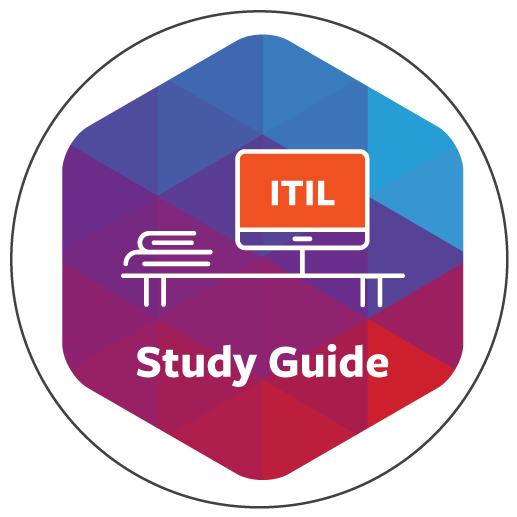ITIL 4 Foundation Study Guide ›
About the ITIL Foundation Certification

ITIL Foundation is the entry level certification that demonstrates an awareness of key ITIL best practices. It is the prerequisite for any further ITIL certifications. To earn the ITIL Foundation certification, you must correctly answer 26 questions on a 40 question multiple-choice exam (65%). Each question will include 4 possible answers from which you must provide the best answer to the question. Most people have 1 hour to complete the exam. People who are not taking the exam in their native language have an additional 15 minutes to finish and may use a dictionary.
The ITIL Foundation certification does not expire or require continuing education to maintain.
Download Now: ITIL 4 Best Practice e-Books
These all-new for 2020 ITIL e-books highlight important elements of ITIL 4 best practices. Quickly understand key changes and actionable concepts, written by ITIL 4 contributors.
ITIL Foundation Exam Administration
You are not required to take an ITIL training course before you sit for the exam, but training is strongly recommended. If you are planning on earning higher level ITIL certifications, then it would be worthwhile to get formal training, since it includes more detailed discussion on how the pieces fit together instead of just preparing you to pass the Foundation exam.
Taking the exam costs around $300. Training organizations usually include the cost for taking the exam in their course fee and can administer the exam right after training is complete.
You may take the exam at a testing center (ex. Prometric). On the testing center’s website, you will schedule a specific date and time to take the exam. Make sure you read and follow the test center regulations. Know what forms of identification are required and leave unallowed items at home. You may be searched when you check into the testing center or if you leave the exam room for a break. Foam earplugs and a sweater/light jacket are typically permitted, but check your location’s regulations to confirm what you can and cannot bring to the testing center.
You may also take the exam online without going to an exam center. If you choose this option, you must use a webcam. A proctor will greet you, walk you through the examination process, and then observe while you take the exam.
The exam may be administered online or on paper. If it is administered online, you will receive a preliminary score once you have completed the exam. Paper exams are sent off to be graded. Final scores and certificates are available within a few weeks after taking the exam.
Exam Resources
Axelos (www.axelos.com)
Axelos is the worldwide manager of multiple best practice methodologies, including ITIL. They provide a number of resources for the exam, including books, sample exams, and an iPhone app.
ATO’s – Authorized Training Organizations
Axelos works with Examinations Institutes (EI), worldwide partners who are authorized to provide training and administer examinations. These partners provide both in person and online resources.
To find an authorized partner near you or learn which online resources are authorized, click on the following links:
Acquiros
APMG International
BCS
EXIN
PEOPLECERT
Sample Exams – Taking sample exams is highly recommended. These samples illustrate the types of questions typically asked. More importantly, you become familiar with the way questions are worded so that you can find the correct answers in the shortest period of time and avoid traps.
The only sample exams confirmed to be accurate and up-to-date are the ones from Axelos, the EI’s, and authorized training partners. Training classes offer at least one sample exam.
Axelos – Axelos also offers an iPhone app with 300 sample exam questions.
APMG International – Sample Exam.
General Examination Tips
- You are not penalized for wrong answers. If you have drawn a blank, choose an answer to give yourself a chance.
- Drop perfectionism. The exam is pass/fail. There is no bonus credit for answering more than 26 questions correctly.
- Tips for checking your answers before submitting your exam:
- Read through each question to make sure you did not fall into any traps.
- Count how many answers you are sure you have gotten correct. If you have more than 26, then submit the exam. If you are a cautious person, submit the exam when you have more than 28 correct.
Key to Success: Avoid the Traps
The ITIL Foundation exam has a high pass rate. Statistics published in 2013 show a 90% pass rate, and many training providers advertise a 99% pass rate. Those who avoid the key traps will succeed on the exam.
Trap #1: Overthinking
How to avoid the trap: Memorize, don’t analyze.
The exam is multiple choice and testing basic knowledge of ITIL best practices. Memorize high-level concepts and definitions and stay focused on those concepts and definitions. Do not think about how your company does a particular process. Do not think about how you would improve the process. Just answer based on the ITIL materials.
Example: An incident is resolved when:
- The user has sent back a customer satisfaction survey.
- The root cause has been resolved, preventing future incidents.
- The Service Desk confirms that the service has been restored to the correct SLA level.
- The intervention will prevent an exception from occurring.
The answer is C. All four of the answers fit a Service Operation Process, but only C is associated with an Incident. Answer A could be part of the evaluation process for Service Request Fulfillment. Root-cause analysis is part of Problem Management. Exceptions are addressed by Event Management.
Trap #2: Too many choices
How to avoid the trap: Memorize groups.
Some questions offer 2 or more options that may be correct. The answers will involve various combinations of those options, and only one combination is correct. The simplest version of this question is to present two options and offer these four potential answers: #1 only, #2 only, both, or neither. Frequently, there will be 4 options and 4 combinations presented.
Example: Which of the following activities are included in Access Management?
- Verifying the identity of users requesting access to services.
- Setting the rights or privileges of systems to allow access to authorized users.
- Defining security policies for system access.
- Monitoring the availability of systems that users should have access to.
- 2 and 4 only
- 1 and 3 only
- 2 and 3 only
- 1 and 2 only
The answer is D. Access management processes include verification (#1), providing rights (#2), monitoring identity status, logging and tracking access, and removing or restricting rights.
Trap #3: Out of order
How to avoid the trap: Learn acronyms. Memorize lists in their correct order.
It’s not always enough to know the items in a list. If they are presented in a particular sequence or represented by an acronym, then it is crucial to know the correct order. Knowing the sequence makes the difference between an easy answer and a wild guess.
Example: What is the correct sequence for the knowledge structure?
- Information, Data, Knowledge, Wisdom
- Data, Information, Wisdom, Knowledge
- Information, Data, Wisdom, Knowledge
- Data, Information, Knowledge, Wisdom
The answer is D. The knowledge structure is also known as the DIKW structure.
Trap #4: Speed reading
How to avoid the trap: Read each question carefully.
Some questions are worded in a way that would trip up someone who did not read every word of the question. Do not read the first few words and jump down to the answers. Each question has some keywords that will either make the right answer obvious or quickly eliminate one or more possible answers.
Two common ways to trap speed readers are:
- Asking for the best answer or the answer that most closely fits. Some questions provide word-for-word definitions, while others include a slight change. In some cases, there may be two possible answers that are nearly identical. You’ll need to read the answers to discover the difference between the two answers and choose the correct one.Example: The BEST definition of an event is:
-
-
- An occurrence where a performance threshold has been exceeded and an agreed Service Level has already been impacted.
- An occurrence that is significant for the management of configuration items or delivery of services.
- A known system defect that generates multiple incident reports.
- A planned meeting of customers and IT staff to announce a new service or improvement program.
-
The answer is B. The first answer is part of Service Level Management. C is a known error and is handled by Problem Management. The planned meeting described by D is part of Release and Deployment Management.
- Using negative descriptors, such as NOT or EXCEPT. Instead of choosing the correct answer, you will be asked to choose the incorrect answer.
Example: Which of the follow is NOT one of the ITIL core processes?- Service Optimization
- Service Transition
- Service Design
- Service Strategy
The answer is A. The core processes are Service Strategy, Service Design, Service Transition, Service Operation, and Continual Service Improvement.
As you read more practice questions, you will recognize the keywords that can easily point to the correct answer or eliminate possible answers. Memorizing the material in its proper order and understanding how exam questions are worded are the biggest keys to success.
What to Study
Please note: This is not a comprehensive list. The purpose of this list is to highlight the more common question types that appear on the Foundation Certification exam.
For a more comprehensive listing, download the Foundation Syllabus from the Axelos site if it has not been included with your training materials. Axelos provides this syllabus to ensure that ATO’s cover the appropriate material in their training. If you are doing self-study, the suggested training timeframes help you prioritize what material to study and how much time to spend studying each topic.
Study Tips
The Foundation syllabus breaks down levels of understanding into Comprehension and Awareness. Comprehension topics require a deeper level of knowledge and will require more understanding. Comprehension goes beyond memorizing definitions and includes understanding why and how the concept impacts the business. Awareness topics do not go in-depth, so in most cases they can be addressed by memorizing key definitions.
Comprehension:
- Service management as a practice
- ITIL lifecycle
- Key principles and models
Awareness:
- Generic concepts and definitions
- Selected processes
- Selected functions
- Selected roles
- Technology and architecture
- Competence and training
For each stage you MUST:
- Know the purpose, objectives, scope and value to the business.
- Know the processes in each stage.
The 5 stages have a total of 22 processes.
- For all processes, know the purpose, objectives, and scope.
- For the 4 core processes, also know the basic concepts, process activities, and interfaces. The core processes are:
- Service Level Management (Service Design stage)
- Change Management (Service Transition stage)
- Incident Management (Service Operation stage)
- Problem Management (Service Operation stage)
Introduction ›
Key Concepts:
- ITIL – Understand what it is, the five stages, benefits and advantages.
- Lifecycle
- RACI – Used to clearly define roles. Stands for Responsible, Accountable, Consulted, Informed
Responsible – Person or people responsible for getting the job done. Each action or decision must have at least one role marked as R.
Accountable – The one person held accountable for each action. One and only one A can be designed for each action or decision.
Consulted – People whose opinions are sought.
Informed – People kept up-to-date on progress.
- Process – Define and identify the 4 process characteristics
- Measureable
- Specific Results
- Delivers to Customers
- Responds to a Specific Event
Key Definitions:
- IT Service Management
- Service
- Customers – Users use the service, customers pay for the service
- Function
- Role
Key Roles:
- Process Owner
Service Strategy ›
Key Concepts:
- Service Strategy is a market-driven approach.
- Services realized through service assets enhances performance of customer assets which improves customer outcome. Improved outcome = Created value
- Assets – applications, process, people, etc.
- Customer assets – used to create value for their own customers in the form of goods and services
- Service assets – owned by internal or external IT organizations to create value through the services they offer
- 9 types of assets:
- Capabilities – an organization’s ability to coordinate, control, and deploy assets to produce value. Asset capabilities are:
Management
Organization
Processes
Knowledge
- Resources – direct inputs for value creation. Asset resources are:
Financial Capital
Infrastructure
Applications
Information
- People is the ninth asset type and is both a capability and a resource.
Key Definitions:
- Service Value = Utility (fit for purpose) + Warranty (fit for use)
- Service Portfolio
- Governance
- Business Case
- Risk Management
- Outcomes
Key Roles:
- Service Provider
- Supplier
Service Design ›
Core Process – Service Level Management
Service Level Management Agreements
Between Customer and IT Organization
Service Level Requirements (SLR)
Service Level Agreements (SLA)
Between IT Organization and External Providers (Suppliers)
Underpinning Contract (UC)
Between IT Organization and Internal Providers (Departments)
Operational Level Agreements (OLA)
3 different SLA structures
Service-based (2 tier)
Customer-based (2 tier)
Multi-level (3 tier)
Corporate level
Customer level
Service level
SLA Monitoring Chart (SLAM)
Service Review
Service Improvement Plan (SIP)
Relationship between Service Level Management (SLM) and Business Relationship Manager (BRM)
Key Concepts:
- Service design aspects
- Service solutions
- Systems and tools
- Technology & architecture
- Process design
- Measurement systems – 4 types of metrics
- Progress
- Compliance
- Effectiveness
- Efficiency
- 4 P’s
- People – only people can be ITIL-certified
- Processes
- Products
- Partners
Service Catalog (2 view and 3 view)
- A database or structured document with information about all live IT services that includes those available for deployment.
- The only part of the service portfolio that is published to customers.
- Includes information about deliverables, prices, contact points, ordering, and requested processes.
Key Definitions:
- Service Design Package
- Availability
Key Role:
- Process owner
- Process manager
- Process practitioner
- Service level manager
- Service owner
Service Transition ›
Core Process – Change Management
- What is a change
- Standard change
- Emergency Change
- Normal Change
- Change proposals
Key Definitions:
- Service Knowledge Management System (SKMS)
- Configuration Item (CI)
- Configuration Management System (CMS)
- Definitive Media Library (DML)
- Release Policy
Service Operation ›
Core Process – Incident Management
- Know how priority is determined
- Understand support levels and the steps in the incident process.
- Incident management includes any event which disrupts or could disrupt a service.
- Know the different statuses for an incident, particularly resolved. One of the easiest mistakes to make is confusing the resolution of an incident vs. resolution of a problem.
Core Process – Problem Management
- Know the definition of a problem and the differences between an incident and a problem.
- Important terms include root cause, known error, and workaround. Understand the scope of problem management and the steps in the problem management process.
Other Processes:
- Understand the purpose of event management, the scope and benefits, the correlation levels, and the process flow.
- Know the three types of events and the appropriate response to each.
- Define alert.
- Understand the purpose of request fulfillment, the objectives, the scope, and the processes and subprocesses.
- Know the definitions of a service request and standard change, be familiar with the metrics that could be used to evaluate performance.
Access Management – Understand the definitions, activities, and processes.
Key Concept:
Know the 4 Functions and 4 Types of Services Desks
Functions:
IT Operations Management
Technical Management
Application Management
- Central
- Local or Distributed
- Virtual
Follow the Sun - Specialized
Key Definitions:
- Priority = Urgency x Impact
- Impact = Effect upon the business
- Urgency = Extent to which the resolution can bear delay
Key Roles:
- Incident Manager
- Service Desk Staff
- 2nd, 3rd, nth Line Specialists
- Problem Manager
- Information Security Managers
Continual Service Improvement ›
Key Concepts:
- Explain the CSI Approach
- CSI Register
- Seven Step Improvement Process
- Deming Cycle – Plan, Do, Check, Act
- Role of measurement
- Relationship between Critical Success Factors (CSF) and Key Performance Indicators (KPI)
- Baselines
- Types of Metrics
- Technology metrics
- Process metrics
- Service metrics
Conclusion
To obtain the ITIL Foundation Certification, you must answer at least 26 out of 40 multiple-choice questions on the examination. Focusing on the key topics and memorizing ITIL definitions will lead to success. Good luck on the examination.








